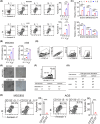Cholesterol-regulated cellular stiffness may enhance evasion of NK cell-mediated cytotoxicity in gastric cancer stem cells
- PMID: 38494433
- PMCID: PMC11073496
- DOI: 10.1002/2211-5463.13793
Cholesterol-regulated cellular stiffness may enhance evasion of NK cell-mediated cytotoxicity in gastric cancer stem cells
Abstract
Gastric cancer has a high rate of recurrence, and as such, immunotherapy strategies are being investigated as a potential therapeutic strategy. Although the involvement of immune checkpoints in immunotherapy is well studied, biomechanical cues, such as target cell stiffness, have not yet been subject to the same level of investigation. Changes in the cholesterol content of the cell membrane directly influence tumor cell stiffness. Here, we investigated the effect of cholesterol on NK cell-mediated killing of gastric cancer stem-like cells. We report that surviving tumor cells with stem-like properties elevated cholesterol metabolism to evade NK cell cytotoxicity. Inhibition of cholesterol metabolism enhances NK cell-mediated killing of gastric cancer stem-like cells, highlighting a potential avenue for improving immunotherapy efficacy. This study suggests a possible effect of cancer cell stiffness on immune evasion and offers insights into enhancing immunotherapeutic strategies against tumors.
Keywords: NK cell; SREBP2; cancer stem cells; cholesterol; gastric cancer; immunotherapy.
© 2024 The Authors. FEBS Open Bio published by John Wiley & Sons Ltd on behalf of Federation of European Biochemical Societies.
Conflict of interest statement
The authors declare no conflict of interest.
Figures






Similar articles
-
Overexpression of DAPK1-mediated inhibition of IKKβ/CSN5/PD-L1 axis enhances natural killer cell killing ability and inhibits tumor immune evasion in gastric cancer.Cell Immunol. 2022 Feb;372:104469. doi: 10.1016/j.cellimm.2021.104469. Epub 2021 Dec 10. Cell Immunol. 2022. PMID: 35114597
-
Natural killer cell-based adoptive immunotherapy eradicates and drives differentiation of chemoresistant bladder cancer stem-like cells.BMC Med. 2016 Oct 21;14(1):163. doi: 10.1186/s12916-016-0715-2. BMC Med. 2016. PMID: 27769244 Free PMC article.
-
Prostaglandin E2 Secreted by Thyroid Cancer Cells Contributes to Immune Escape Through the Suppression of Natural Killer (NK) Cell Cytotoxicity and NK Cell Differentiation.Front Immunol. 2018 Aug 9;9:1859. doi: 10.3389/fimmu.2018.01859. eCollection 2018. Front Immunol. 2018. PMID: 30140269 Free PMC article.
-
Natural killer cells target and differentiate cancer stem-like cells/undifferentiated tumors: strategies to optimize their growth and expansion for effective cancer immunotherapy.Curr Opin Immunol. 2018 Apr;51:170-180. doi: 10.1016/j.coi.2018.03.022. Epub 2018 Apr 10. Curr Opin Immunol. 2018. PMID: 29653339 Review.
-
Therapeutic Potential of Natural Killer Cells in Gastric Cancer.Front Immunol. 2019 Jan 21;9:3095. doi: 10.3389/fimmu.2018.03095. eCollection 2018. Front Immunol. 2019. PMID: 30719024 Free PMC article. Review.
Cited by
-
Decoding the role of cancer stem cells in digestive tract tumors: Mechanisms and therapeutic implications (Review).Int J Oncol. 2025 Jul;67(1):61. doi: 10.3892/ijo.2025.5767. Epub 2025 Jun 27. Int J Oncol. 2025. PMID: 40576138 Free PMC article. Review.
-
SREBP2 as a central player in cancer progression: potential for targeted therapeutics.Front Pharmacol. 2025 Apr 16;16:1535691. doi: 10.3389/fphar.2025.1535691. eCollection 2025. Front Pharmacol. 2025. PMID: 40308757 Free PMC article. Review.
References
-
- Smyth EC, Nilsson M, Grabsch H, Ivan Grieken NC and Lordick F (2020) Gastric cancer. Lancet 396, 635–648. - PubMed
-
- Johnston FM and Beckman M (2019) Updates on management of gastric cancer. Curr Oncol Rep 21, 67. - PubMed
-
- Badgwell B (2016) Multimodality therapy of localized gastric adenocarcinoma. J Natl Compr Cancer Netw 14, 1321–1327. - PubMed
-
- Paoletti X, Oba K, Burzykowski T, Michiels S, Ohashi Y, Pignon JP, Rougier P, Sakamoto J, Sargent D, Sasako M et al. (2010) Benefit of adjuvant chemotherapy for resectable gastric cancer: a meta‐analysis. JAMA 303, 1729–1737. - PubMed
Publication types
MeSH terms
Substances
Grants and funding
LinkOut - more resources
Full Text Sources
Medical

